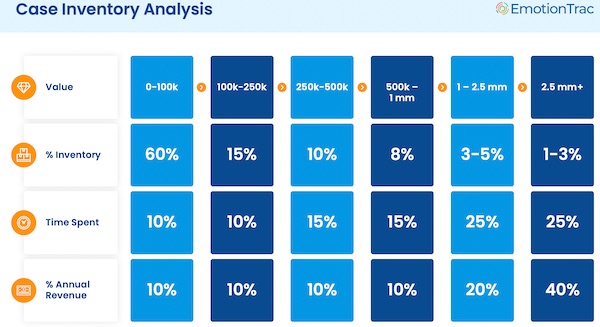The Power of High-Value Cases: A Look at Case Inventory Analysis
When it comes to legal cases, not all are created equal.
While the bulk of cases in many law firms tend to be lower in value, the high-value cases are the real game-changers when it comes to revenue generation and time investment.
Let’s break down why understanding your case inventory distribution can reveal key insights into your firm's performance and strategy:
The Inventory Breakdown: Quantity vs. Quality
A Case Inventory Analysis typically shows that the majority of cases (in this example, 60%) are valued under $100K.

These small cases may seem like the bread and butter of the practice, but in reality, they contribute minimally to the firm’s overall revenue—just 10%, to be exact.
Even in terms of time, they consume only 10% of the firm’s efforts. So, while these cases come in large numbers, their actual contribution to the bottom line is relatively small.
Now, let’s talk about high-value cases:
Cases valued between $1M and $2.5M might only make up 3-5% of the total inventory, but they account for a whopping 20% of the firm’s revenue.
And when you look at cases over $2.5M, the numbers get even more staggering.
These cases represent just 1-3% of the inventory, yet they generate 40% of the firm’s revenue and require 25% of the firm’s time. This data makes it clear that the fewer, bigger cases are worth far more than their smaller, more frequent counterparts.
Why This Matters for Your Firm
This distribution presents an important insight for law firms:
Big cases drive business. While it might seem intuitive to take on as many cases as possible, focusing on attracting and nurturing high-value cases could be far more effective in boosting your firm’s overall profitability.
The key takeaway here is that while smaller cases are essential to keep the pipeline flowing, the real revenue drivers are those high-value cases that demand more time but offer a higher return.
Knowing this, firms can make more strategic decisions about where to focus their time and resources.
High-value cases not only offer a significant revenue boost, but they also demand more attention, which means they offer opportunities to showcase the firm’s expertise and dedication to achieving favorable outcomes.
Balancing Time and Revenue
The challenge, of course, is finding the balance.
Firms still need smaller cases to ensure a steady stream of work, but understanding the value-to-time ratio can help in making smarter business decisions.
With this data, firms can consider where they might need to increase efforts to attract higher-value cases or better manage their time allocation.
In conclusion, while smaller cases form the bulk of a firm’s workload, high-value cases deliver the greatest returns.
Knowing where your cases fall on this spectrum can help you make more informed decisions, better manage your resources, and ultimately drive more revenue.
The Case Inventory Analysis is a powerful tool for identifying where your firm's strengths lie and where improvements can be made. It reminds us that in the legal world, quality often trumps quantity when it comes to profitability and growth.
By focusing on building strategies around high-value cases, your firm can position itself for long-term success, while still maintaining the flow of smaller cases that keep the wheels turning.


